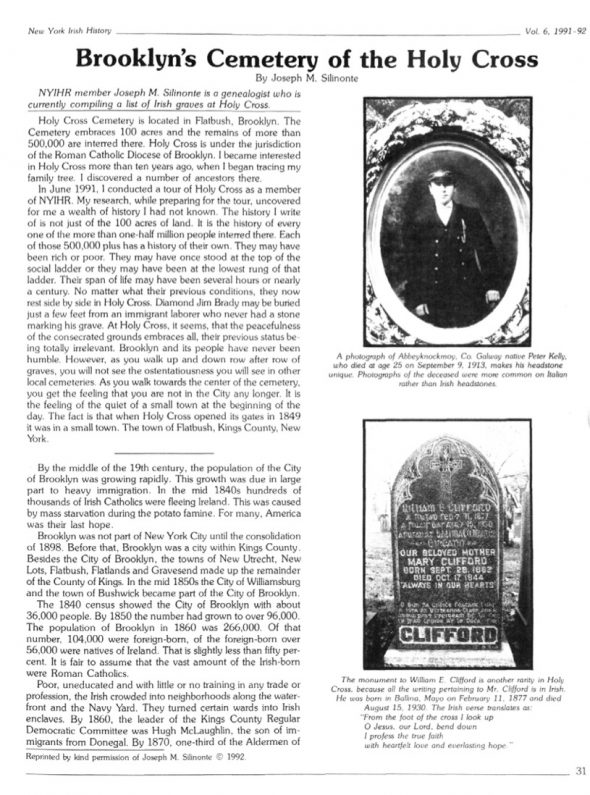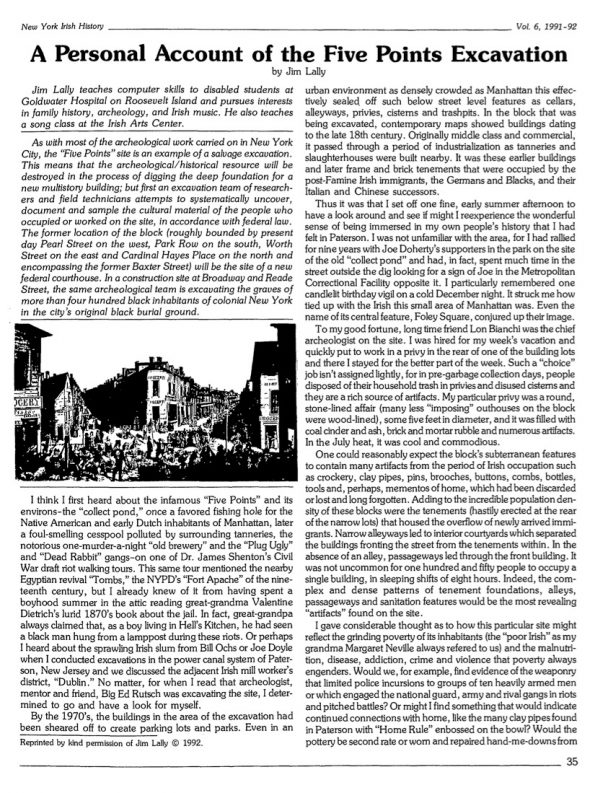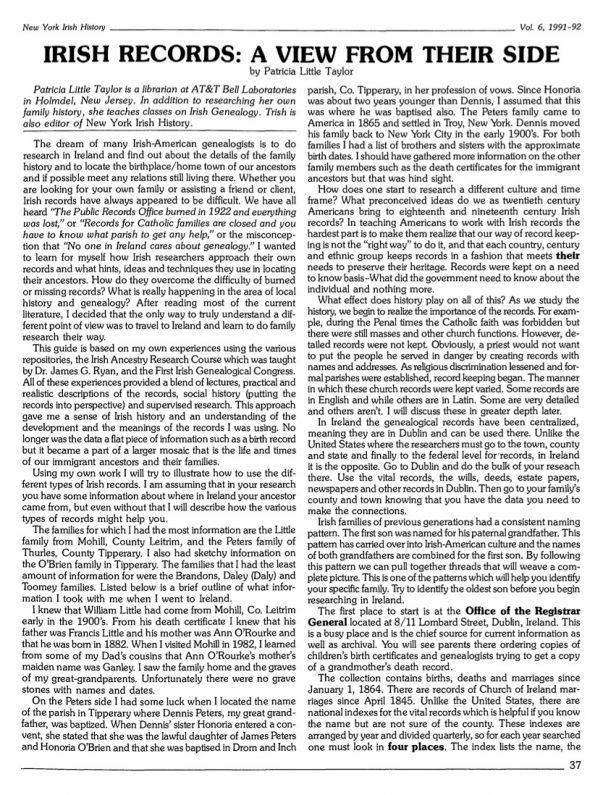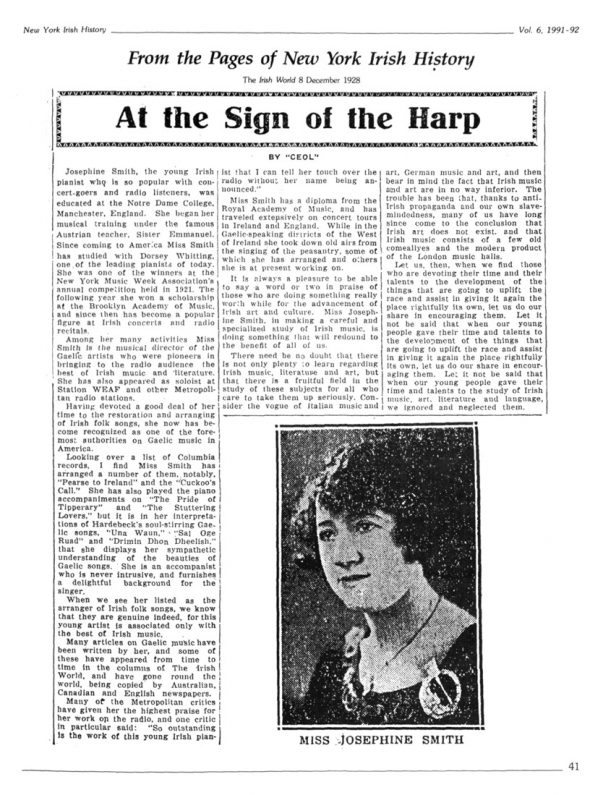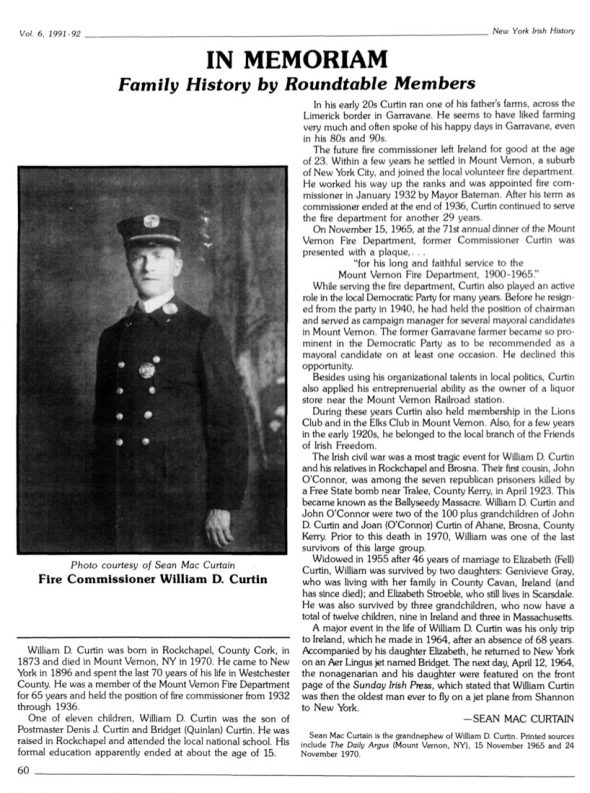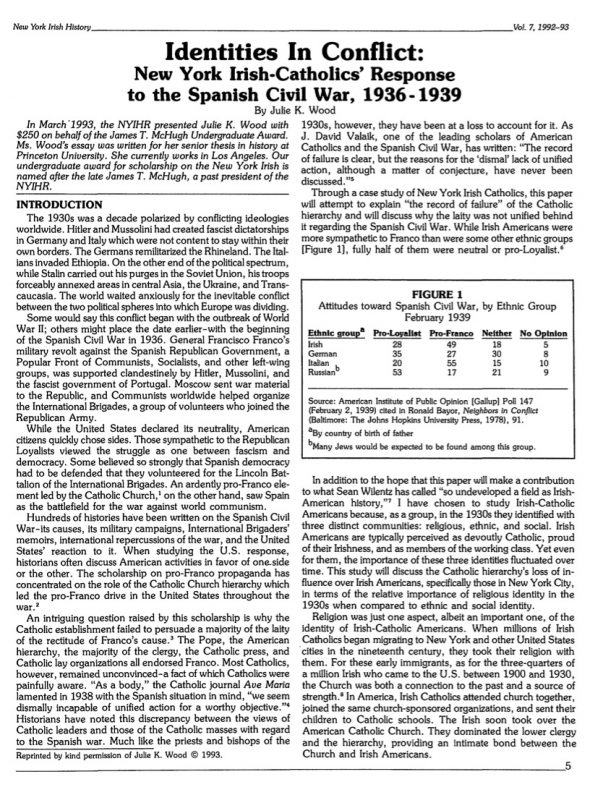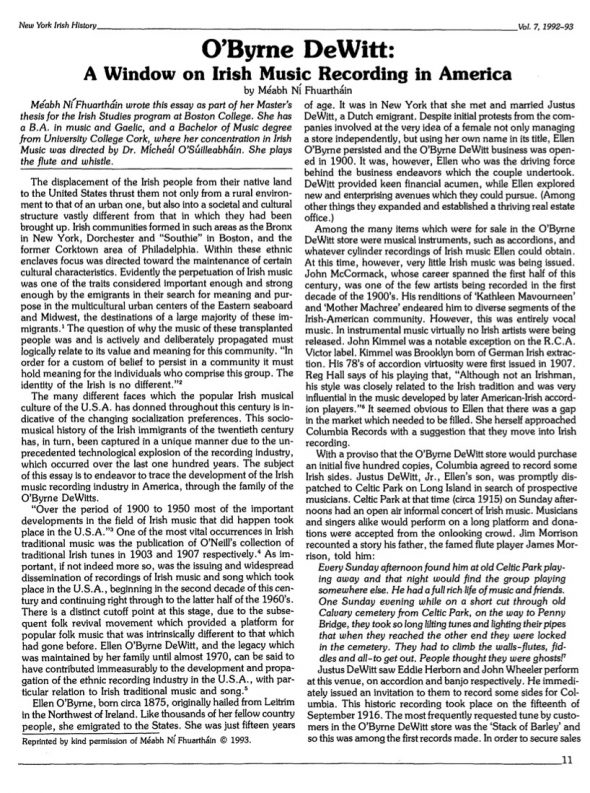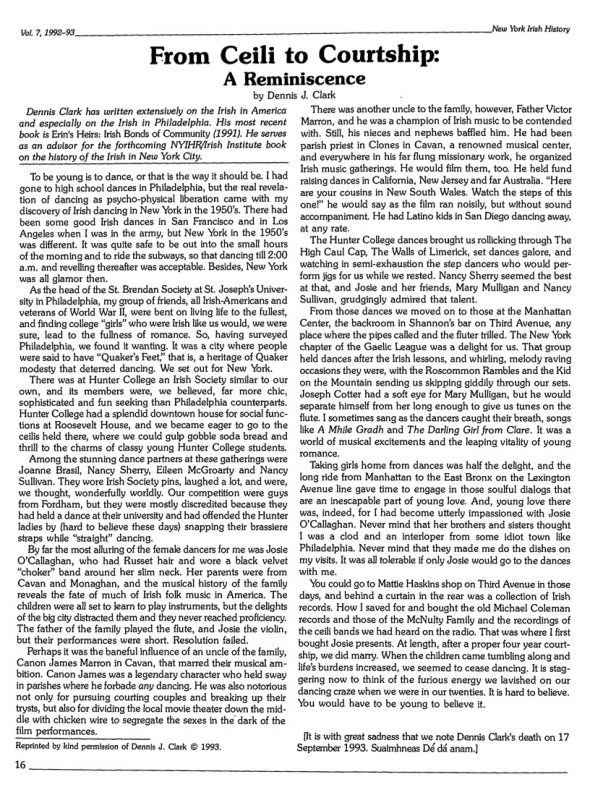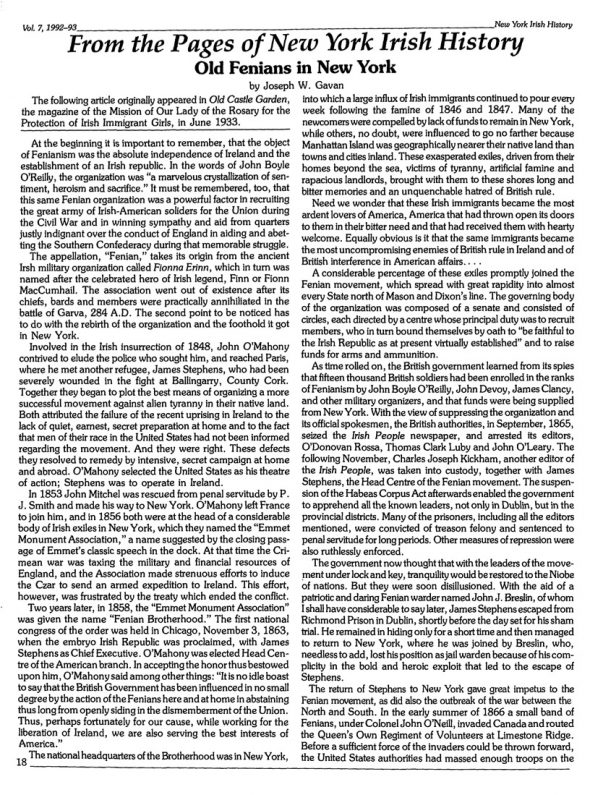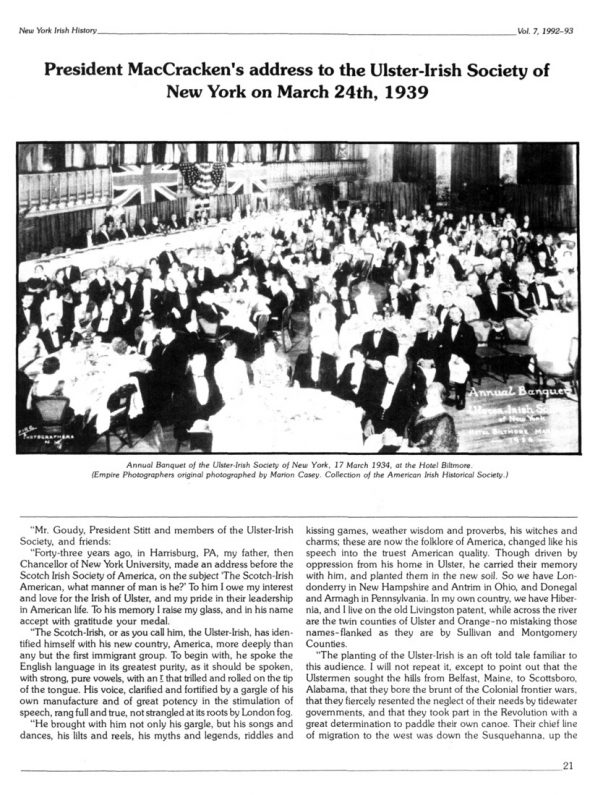New York Irish History Roundtable - Journal Articles
Brooklyns Cemetery of the Holy Cross
Author: Joseph Silinonte
Publication Year: 1991-92
Journal Volume: 06
Article Reference: NYIHR-V06-05
Holy Cross Cemetery is located in Flatbush, Brooklyn. The Cemetery embraces 100 acres and the remains of more than 500,000 are interred there. Holy Cross is under the jurisdiction of the Roman Catholic Diocese of Brooklyn. I became interested in Holy Cross more than ten years ago, when I began tracing my family tree. I discovered a number of ancestors there.
In June 1991, I conducted a tour of Holy Cross as a member of NYIHR. My research, while preparing for the tour, uncovered for me a wealth of history I had not known. The history... [Read Full Article]
A Personal Account of the Five Points Excavation
Author: Jim Lally
Publication Year: 1991-92
Journal Volume: 06
Article Reference: NYIHR-V06-06
As with most of the archeological work carried on in New York City, the "Five Points" site is an example of a salvage excavation.
This means that the archeological/historical resource will be destroyed in the process of digging the deep foundation for a new multistory building; but first an excavation team of researchers and field technicians attempts to systematically uncover, document and sample the cultural material of the people who occupied or worked on the site, in accordance with federal law.
The former location of the... [Read Full Article]
Irish Records - A View From Their Side
Author: Patricia Little Taylor
Publication Year: 1991-92
Journal Volume: 06
Article Reference: NYIHR-V06-07
The dream of many Irish-American genealogists is to do research in Ireland and find out about the details of the family history and to locate the birthplace/home town of our ancestors and if possible meet any relations still living there. Whether you are looking for your own family or assisting a friend or client, Irish records have always appeared to be difficult. We have all heard "The Public Records Office burned in 1922 and everything was lost," or "Records for Catholic families are closed and you have to know what parish to get any... [Read Full Article]
From the Pages of New York Irish History
Author: New York Irish History Roundtable
Publication Year: 1991-92
Journal Volume: 06
Article Reference: NYIHR-V06-08
The young Irish pianist who is so popular with concert-goers and radio listeners, was educated at the Notre Dame College, Manchester, England. She began her musical training under the famous i Austrian teacher. Sister Emmanuel. j Since coming to America Miss Smith ! has studied with Dorsey Whitting. one,of the leading pianists of today.
She was one of the winners at the New York Music Week Association's annual competition held in 1921. The following year she won a scholarship at the Brooklyn Academy of Music, and since then has... [Read Full Article]
IN MEMORIAM - Family History by Roundtable Members
Author: New York Irish History Roundtable
Publication Year: 1991-92
Journal Volume: 06
Article Reference: NYIHR-V06-09
Fire Commissioner William D. Curtin William D. Curtin was born in Rockchapel, County Cork, in 1873 and died in Mount Vernon, NY in 1970. He came to New York in 1896 and spent the last 70 years of his life in Westchester County. He was a member of the Mount Vernon Fire Department for 65 years and held the position of fire commissioner from 1932 through 1936. One of eleven children, William D. Curtin was the son of Postmaster Denis J. Curtin and Bridget (Quinlan) Curtin. He was raised in Rockchapel and attended the local national school. His... [Read Full Article]
Identities In Conflict - New York Irish-Catholics Response to the Spanish Civil War, 1936-1939
Author: Julie K. Wood
Publication Year: 1993
Journal Volume: 07
Article Reference: NYIHR-V07-01
The 1930s was a decade polarized by conflicting ideologies worldwide. Hitler and Mussolini had created fascist dictatorships in Germany and Italy which were not content to stay within their own borders. The Germans remilitarized the Rhineland. The Italians invaded Ethiopia. On the other end of the political spectrum, while Stalin carried out his purges in the Soviet Union, his troops forceably annexed areas in central Asia, the Ukraine, and Transcaucasia. The world waited anxiously for the inevitable conflict between the two political... [Read Full Article]
OByrne DeWitt - A Window on Irish Music Recording in America
Author: Meabh Ni Fhuarthain
Publication Year: 1993
Journal Volume: 07
Article Reference: NYIHR-V07-02
The displacement of the Irish people from their native land to the United States thrust them not only from a rural environment to that of an urban one, but also into a societal and cultural structure vastly different from that in which they had been brought up. Irish communities formed in such areas as the Bronx in New York, Dorchester and "Southie" in Boston, and the former Corktown area of Philadelphia. Within these ethnic enclaves focus was directed toward the maintenance of certain cultural characteristics. Evidently the perpetuation of... [Read Full Article]
From Ceili to Courtship - A Reminiscence
Author: Dennis J. Clark
Publication Year: 1993
Journal Volume: 07
Article Reference: NYIHR-V07-03
To be young is to dance, or that is the way it should be. I had gone to high school dances in Philadelphia, but the real revelation of dancing as psycho-physical liberation came with my discovery of Irish dancing in New York in the 1950's. There had been some good Irish dances in San Francisco and in Los Angeles when I was in the army, but New York in the 1950's was different. It was quite safe to be out into the small hours of the morning and to ride the subways, so that dancing till 2:00 a.m. and revelling thereafter was acceptable.... [Read Full Article]
From the Pages of New York Irish History, Old Fenians in New York
Author: Joseph W. Gavan
Publication Year: 1993
Journal Volume: 07
Article Reference: NYIHR-V07-04
At the beginning it is important to remember, that the object of Fenianism was the absolute independence of Ireland and the establishment of an Irish republic. In the words of John Boyle O'Reilly, the organization was "a marvelous crystallization of sentiment, heroism and sacrifice." It must be remembered, too, that this same Fenian organization was a powerful factor in recruiting the great army of Irish-American soliders for the Union during the Civil War and in winning sympathy and aid from quarters justly indignant over the conduct of... [Read Full Article]
President MacCrackens address to the Ulster-Irish Society of New York on March 24th, 1939
Author: New York Irish History Roundtable
Publication Year: 1993
Journal Volume: 07
Article Reference: NYIHR-V07-05
Forty-three years ago, in Harrisburg, PA, my father, then Chancellor of New York University, made an address before the Scotch Irish Society of America, on the subject 'The Scotch-Irish American, what manner of man is he?' To him I owe my interest and love for the Irish of Ulster, and my pride in their leadership in American life. To his memory I raise my glass, and in his name accept with gratitude your medal. "The Scotch-Irish, or as you call him, the Ulster-Irish, has identified himself with his new country, America, more deeply than any... [Read Full Article]

